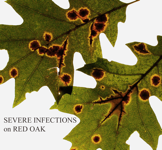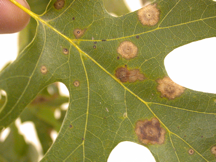Download Tubakia (actinoplete) leaf spot factsheet(PDF) (PLPA-102)
 This disease can occur on many species of oak, but are most prevalent on red oaks.
This disease can occur on many species of oak, but are most prevalent on red oaks.
CAUSAL AGENT
Tubakia (formerly known as Actinopelte) dryina (fungus)
The fungus survives over the winter in affected twigs and foliage. In the following growing year, overwintering spores of this fungus are disseminated by wind and rain-splashing.
ENVIRONMENTAL CONDITIONS
This disease is most severe in late summer and early fall. This disease is more prevalent during years that are wet. Also, this disease often occurs on oak trees that are under various stresses such as nutritional deficiencies, in particular iron deficiency. Newly transplanted trees are more susceptible to attacks by this fungus than well-established trees.
SYMPTOMS
Leaf spots are circular in shape with a diameter of ¼ – ½ inches, and are dark to reddish brown in color. Spots may coalesce to form irregular blotches. Spots are also typically surrounded by a chlorotic (yellowing) halo. Severe infected leaves prematurely defoliate.
 MANAGEMENT
MANAGEMENT
Determine the stress factors that may be predisposing the oak tree to this fungal pathogen. If possible, correct the conditions to minimize stress on the tree. With newly transplanted tree, ensure proper mulching and fertilization to encourage establishment.
Infected leaves should be collected and destroyed to minimize the spread of the disease. Removal of some branches to increase air movement will also help minimize incidences of tubakia leaf spot. Trees that are severely defoliated by this fungus should be fertilized slightly more than normal to stimulate new growth. Although chemical treatments are not warranted, several broad spectrum fungicides are available for use as a preventative measure. For more information, please contact your local Extension county agent.
Prepared by Dr. Kevin Ong
Assistant Professor and Extension Urban Plant Pathologist
Texas AgriLife Extension Service; The Texas A&M University System
August 27, 2002 (rev.032508)
The information given herein is for educational purposes only. References to commercial products or trade names are made with the understanding that no discrimination is intended and no endorsement by Texas AgriLife Extension Service personnel is implied.
Educational programs of the Texas AgriLife Extension Service are open to all people without regard to race, color, sex, disability, religion, age, or national origin.
The Texas A&M University System, U.S. Department of Agriculture, and the County Commissioners Courts of Texas Cooperating